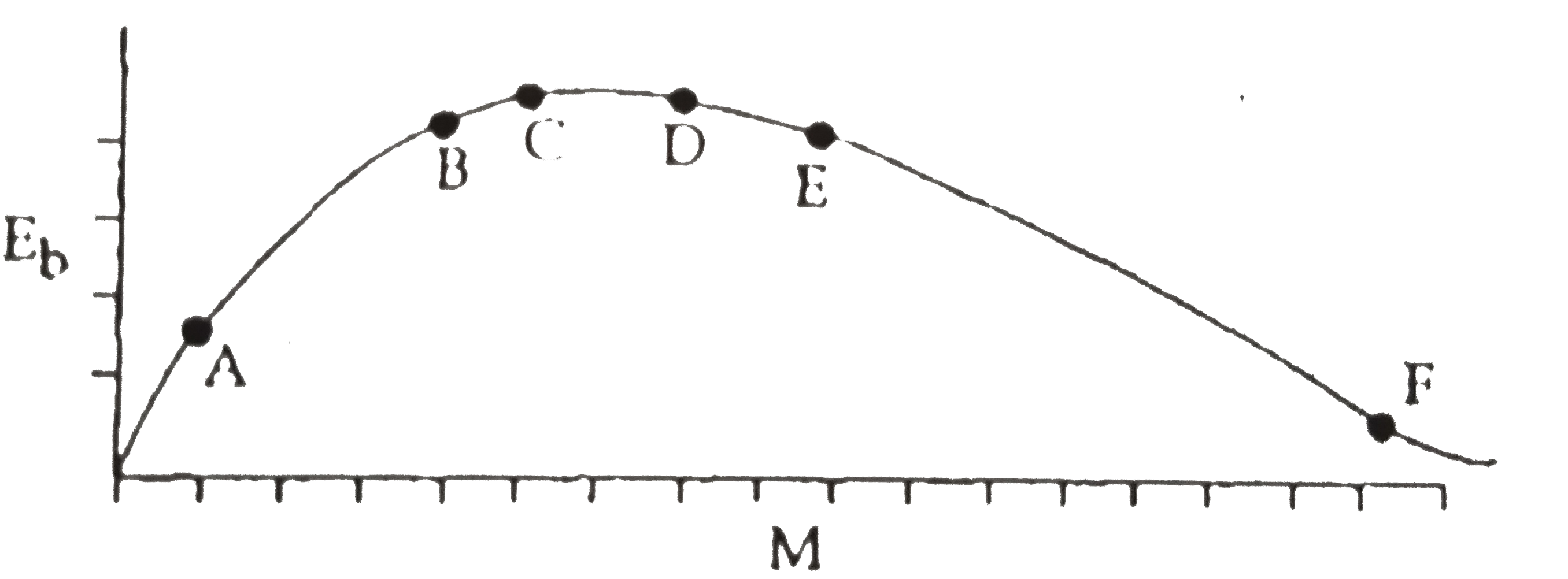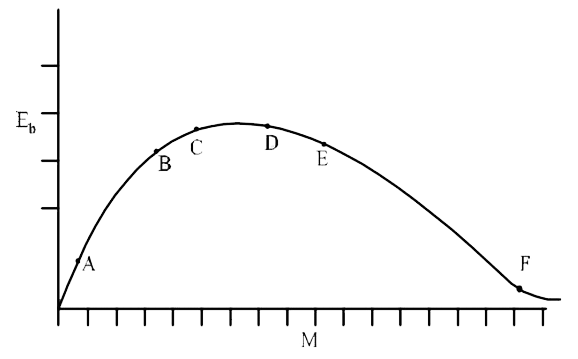The above is a plot of binding energy per nucleon Eb, against the nuclear mass M, A, B, C, D, E, F correspond to different nuclei. Consider four reactions
(i) A+B→C+ε (ii) C→A+B+ε
(iii) D+E→F+ε and (iv) F→D+E+ε
where ε is the energy released ? In which reactions is ε positive ?

(i) and (iii)
(ii) and (iv)
(ii)and (iii)
(i) and (iv)
The correct Answer is:d
Energy (ε) is released when lighter nuclei fuse to form a heavier nucleus , such as in (i) A+B→C+ε
Again, energy is released when a heavy nucleus splits into lighter nuclei , such as in (iv) F→D+E+ε.
Topper's Solved these Questions
- NUCLEIBOOK - NCERT FINGERTPS ENGLISHCHAPTER - NUCLEIEXERCISE - NCERT Exemplar
7 Videos
- NUCLEIBOOK - NCERT FINGERTPS ENGLISHCHAPTER - NUCLEIEXERCISE - Assertion And Reason
15 Videos
- NUCLEIBOOK - NCERT FINGERTPS ENGLISHCHAPTER - NUCLEIEXERCISE - Nuclear Energy
10 Videos
- MOVING CHARGES AND MAGNETISM BOOK - NCERT FINGERTPS ENGLISHCHAPTER - MOVING CHARGES AND MAGNETISM EXERCISE - Assertion And Reason
15 Videos
- PRACTICE PAPPERBOOK - NCERT FINGERTPS ENGLISHCHAPTER - PRACTICE PAPPEREXERCISE - Practice Paper 3
50 Videos
Similar Questions

The above is a plate of binding energy per nucleon E0 against the nuclear mass M,A,B,C,D,E,F correspond to different nuclei Consider four reactions:
View SolutionThe alongside is a plot of binding energy per nucleon Eb ,against the nuclear mass M,A,B,C,D,E,F correspond to different nuclei. Consider four reactions.
(i) A + B → C +ε (ii) C → A + B + ε
(iii) D + E → F + ε (iv) F → D + E + ε where ε is the energy released. In which reactions , is ε positive?

View Solution
Knowledge Check
Consider this reaction: A+B→C+D+ energy
Athis reaction is exergonicBan enzyme could still speed the reactionCA and B are reactants, C and D are productsDall of the above are correct
A nuclear reaction is given as
A+B→C+D
Binding energies of A,B,C, and D, are given as B1,B2,B3 and B4. Find the energy released in the reaction.
View SolutionA nuclear reaction is given as
A+B→C+D
Binding energies of A,B,C, and D, are given as B1,B2,B3 and B4. Find the energy released in the reaction.
View SolutionOn the basis of given reactions,the correct order of increasing oxidising of A,B,C & D is. [(a)A−+B→A+B− , (b) C+D−→noreaction , (c) C−+B→noreaction, (d) D+A−→D−+A]
View SolutionA following mechanism has been proposed for a reaction
2A+B→D→E
A+B→C+D(slow)
A+C→E (fast)
The rate law expression for the reaction by RDS methd is:
View SolutionIn Figure, DEFG is a square and ∠BAC=90 . Prove that (i) A G F ~ D B G(ii)AGF~EFC (iii) D B G ~ E F C(iv)DE2=BDxEC
View SolutionGiven the following reaction involving A,B,C and D
(i) C+B+→C++B
(ii) A−+D→ NO reaction
(iii) C++A→ NO reaction
(iv) D+B+→D++B
the correct arrangement of A,B,C,D in the order of their decreasing ability as reducing agent
View SolutionIf U={a,b,c,d,e,f,g,h}, find the complements of the following sets :(i) A={a,b,c} (ii) B={d,e,f,g] (iii) C={a,c,e,g} (iv) D={f,g,h,a)
View Solution
